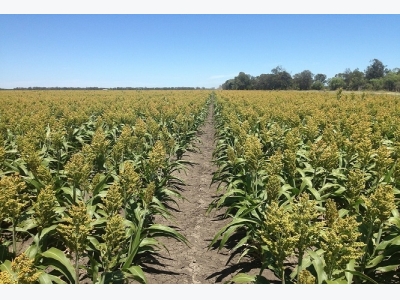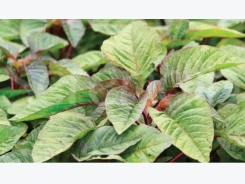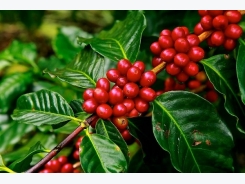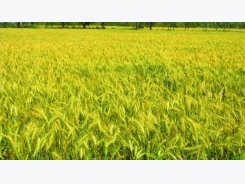Sorghum Production Information Guide

Introduction to Sorghum Production:- Sorghum is one of best millet crop for food and forage (fodder for livestock). This provides very good staple food in highly populated countries in Asia. This millet is also known as ‘Jowar’ in India. Sorghum production plays good role in country economy and exports. Sorghum can be grown with minimal water requirement hence very much suitable for dry lands. According to history, sorghum is originated in Africa and India and spread across other regions of the world. Sorghum is a genus of flowering plants in the grass family and this can be grown for grain as well as livestock fodder. The cultivation practices of sorghum would be the same in both cases except harvesting stage.
USA and Nigeria top producers of sorghum in the world. There is a good scope of sorghum farming and may result in more cultivation areas to increase the production in future to meet the demand for food and livestock fodder supply due to the utilization of grain sorghum as a cattle feed, poultry ration and other industrial uses. When sorghum is grown for fodder purpose, especially dairy farmers can benefit from this in a good way by saving the daily green fodder and dry fodder cost of cattle. Commercial sorghum farming is profitable under ideal crop management practices. Let us discuss more about growing sorghum in the following article.

Sorghum Plant Green Spike.
Scientific Name / Botanical Name of Sorghum:- Sorghum bicolor.
Family Name of Sorghum:- Gramineae.
Genus of Sorghum:- Sorghum.
Common Names of Sorghum or Other Country Names:- Sorgho (French), Sorgum (German), kafferkoren (Dutch), sorgho (Afrikaans), Sorgo (Polish), melekuqe (Albanian), sorgo (Estonian), Σόργο (Greek), satang susu (Korean), झुिमलो (Nepali), Sorgo (Portuguese), Sorgo (Spanish), 粱 (Chinese), sorgo (Filipino), saggina (Italian), ขา้วฟ่าง (Thai), Chi Lúa miến (Vietnamese), sorgo (Armenian), Durra (Finnish), morokoshi (Japanese), Sorgo (Latvian), Sorg (Romanian), Idhal Irihu (Sinhalese), Čirok (Czech), Sorgo (Macedonian), сорго (Russian), durra (Swedish), Süpürge darısı (Turkish), Durra (Danish), სორგო (Georgian), Cirok (Hungarian), Kaoliang (Malay), 高粱 (Taiwanese).
Sorghum in Indian Languages:- Juar / Jowar (Hindi, Bengali, Gujarati), Cholas (Malayalam, Tamil), Jonnalu (Telugu), Jola (Kannada), Jwari (Marathi), Janha (Oriya), other names: Milo, Chari.
World Top 10 Production Countries of Sorghum:- The following are the top 10 production countries of Sorghum as per United States Department of Agriculture (USDA) for the year 2016/2017
- USA (12,199,000 Metric Tons)
- Nigeria (6,500,000 Metric Tons)
- Sudan (5,500,000 Metric Tons)
- Mexico (5,400,000 Metric Tons)
- India (4,800,000 Metric Tons)
- China (3,800,000 Metric Tons)
- Ethiopia (3,700,000 Metric Tons)
- Argentina (3,600,000 Metric Tons)
- Burkina (1,900,000 Metric Tons)
- Brazil (1,530,000 Metric Tons)
Advantages and Uses of Sorghum Production:-
- Sorghum is a staple food of very large population countries of Asia like China and India
- Growing sorghum provides nutritious fodder for the livestock
- Sorghum crop can with stand drought condition and extreme heat and this can be grown with minimum water requirement
- Sorghum crop can tolerate soil salinity & water logging (stagnation) up to certain extent
- One can obtain more yields with hybrid varieties when compared to other cereal crops
- Sorghum crop can be grown in wide range of soils and climatic conditions
- Sorghum crop provides input raw materials to starch, alcohol industries
- Sorghum contributes 50% of the total cereal production in most of the countries
- Sorghum is knows as a great millet because of larger size grains
- Livestock farmers can save lot of money by growing sorghum crop especially dairy farmers
Health Benefits of Sorghum:- The following are some of the health benefits of Sorghum. Regular consumption of sorghum can reduce the chance of developing various types of cancer including oesophageal cancer
- Sorghum can control blood sugar levels hence good for diabetic patients
- Sorghum is gluten free and may relieve from celiac disease
- Sorghum is good for circulation & red blood cell development
- Sorghum helps tom maintain good calcium levels hence is good for bone health
- Sorghum can protect from osteoporosis and arthritis
- Sorghum can prevent melanoma which is kind of skin cancer
- Sorghum is can boost your energy levels
- Sorghum is a good source of “Niacin” also known as vitamin B3
Nutrition values in Sorghum:
Serving Size: Nutritional value per 100 grams of Sorghum.
- Energy – 329 kcal
- Carbohydrates – 72.1 grams
- Dietary fiber – 7 grams
- Fat – 3.5 grams
- Protein – 10.6 grams
Vitamins:
- Thiamine (B1) – 0.33 mg (29%)
- Riboflavin (B2) – 0.1 (8%)
- Niacin (B3) – 3.7 mg (25%)
- Pantothenic acid (B5) – 0.4 mg (8%)
- Vitamin B6 – 0.44 mg (34%)
- Folate (B9) – 20 μg (5%)
Minerals:
- Calcium – 13 mg (1%)
- Iron – 3.4 mg (26%)
- Magnesium – 165 mg (46%)
- Manganese – 1.6 mg (76%)
- Phosphorus – 289 mg (41%)
- Potassium – 363 mg (8%)
- Sodium – 2 mg (0%)
- Zinc – 1.7 mg (18%)
Growth Stages of Sorghum:- The following are main growth stages of sorghum crop.
- Seedling stage – 1 to 15 days
- Vegetative stage – 16 to 40 days
- Flowering / Reproductive stage – 41 to 65 days
- Maturity stage – 66 to 95 days
- Ripening stage – 96 to 105 days
Varieties / Types (Cultivars) of Sorghum:- There are thousands of improved and hybrid varieties grown in many parts of the world. We may not list all the varieties here. However, some of the high yielding cultivars are; 2KNICSV-188, Improved Deko, Dual Forage, DannyBoy BMR,M71GB01, 722B, Dynagraze II, M58GR24, M59GB57, M60GB31, M60GB88, 742C, M3838, 1G600, 766B, FullGraze, FullGraze BMR,M75GB39, 627, F75FS28BMR M-35-1, SPV-462, CSV-13, CSH-1 to CSH-10, CSH-1 and SPV-1359. Contact your local agriculture department for suitable high yielding variety for your region.
Climate Requirement for Sorghum Production:- Sorghum crop can be grown in drought areas as it can tolerate high temperature and drought conditions. The ideal temperature of growing this crop is between 15ºC – 40ºC and it requires annual rainfall of 400 mm to 1000 mm.
Soil Requirement for Sorghum Production:- Sorghum can be grown in wide range of soil types.
However, the clayey loam soil rich in humus is ideal for sorghum production. The advantage pf sorghum is it can tolerate mild acidity to mild salinity under pH 6.0 to 8.5 conditions. Though it can with stand to waterlogging to some extent, a good soil drainage is required for growing the crop.
Land Preparation in Sorghum Production:- Using local tractor, the field should be given couple of ploughings, harrowing and cross planking till the soil reaches fine tilth (pulverised) stage. The field should be levelled before sowing so that rainwater may be well distributed throughout the field.
Propagation in Sorghum Production:- Propagation of Sorghum crop is done by seeds.

Sorghum Seed.
Seed Rate in Sorghum Production:- Seed rate depends on planting method and variety of seeds.
Under Irrigated Conditions
- In case of Transplanted: 5 kg/ha
- Direct seed sown : 10 kg/ha
- Under Rainfed Conditions:
- Direct seed sown: 15 kg/ha
Note: Sorghum crop can be grown under irrigated condition by both direct sown and transplanted methods.
Seed Treatment in Sorghum Production:- Seed treatment may be done to prevent from seed borne diseases and soil borne diseases. Sorghum seeds may be treated with “Thiram” at the rate of 3 grams / kg of seed. The quality sorghum seed may be treated, dried before sowing in the field.
Season, Sowing and Spacing in Sorghum Production:- Sorghum crop can be grown throughout the year provided there is an irrigation facility available. In some Asian countries, this crop is grown under Rainfed conditions.
However, people grow this crop round the clock for livestock fodder to meet the daily requirement of feed. In India, this crop is grown both in Kharif (July-October) and Rabi (October – March) seasons. Sorghum seeds can be sown with drilling, dibbling and plough furrow methods. However, drilling method is most common method of sowing.
Drilling Method:
- The sorghum seed should be drilled with the help of tiffan
- The sorghum seed should be covered with soil by giving harrowing
- In this method, the seed rate is about 10 to 12 kg/ha
- The spacing maintained in this method is about 45 cm x 15 cm
- Crop sown with this method needs thinning 15 days after sowing to maintain plant to plant distance
Dibbling Method:
- In this method, land should be levelled and marked with a maker in both direction
- The spacing should be kept at 45 cm x 45 cm
- A circle of 20 cm diameter should be made at each hill
- Make sure the dry surface of soil is removed with hand in this method, 6 to 7 seeds should be scattered in each circle and covered by moist soil
- Generally, 1st thinning should be carried 15 days after sowing and only 4 or 5 seedlings should be kept in each circle and 2nd thinning should be carried out 3 weeks after sowing and only 2 or 3 healthy sorghum seedlings should be kept in each circle
- In this sowing method, it requires a seed rate of 5 kg /ha
- This method provides optimum space to every plant and which will result higher crop yield.
Plough Furrow Method of Sowing:
- This method is followed when the upper soil surface is dry and lower layer of soil is moist
- One can expect good germination and proper utilization of soil moisture for crop growth
- Seed may be sown using local wooden plough
- In this sowing method, it requires a seed rate of 10-12 kg/ha
- In general a spacing of 40 to 45 cm between the rows and 15 to 20 cm between the plants is ideal in sorghum production. Seeds should be sown 3 to 4 cm deep in the furrows.
Irrigation in Sorghum Production:- Though this crop is drought resistant, you must ensure to maintain moisture in critical stages at knee-height stage, flowering and grain filling stage. Avoid water stagnation and at the same time make sure the soil is moist at critical stages of growth period. The frequency of irrigation may depend on soil type, climate and plant age (stage).
Manures and Fertilizers in Sorghum Production:- Proper application of manure and fertilizers on time ensures good crop growth and high yield.
- Ideal dose of Nitrogen (‘N’): under high yielding and rain fed conditions or local varieties of irrigated crop: 70 to 80 kg /ha For Irrigated high yielding varieties: 120 to 150 kg/ha In case of heavy soils, 1 single application is best when compared to split application. However, in case of light soils split application, it should be applied as half basal and remaining half as top-dressing 1 month after sowing is recommended. Under low rainfall or in Rainfed regions top-dressing of ‘N’ (nitrogen) is not required.
- P2O5 and K2O: On an average 1 ha crop requires 40-60 kg of P2O5 and 40 kg/ha of K2O (Potash). These can be applied as basal and potash can be applied the time of land preparation for better results.
Intercultural Operations in Sorghum Production:- The sorghum crop should be kept weed free and in some season, if possible manual weeding and hoeing should be carried out. Another solution to control weeds is application of appropriate herbicides. These herbicides should be applied before emergence of sorghum seedlings in the field.
Inter-cropping in Sorghum Production:- When it comes to inter-cropping in sorghum production, Sorghum inter-cropped with sunflower, pigeon pea, green gram , black gram or soybean has been found to be effective and widely adopted by the most of the farmers.
Pests and Diseases in Sorghum Production:-
- Pests in Sorghum Production: The common pests found in sorghum production are shoot-fly, stemborer & midges. These peats must be controlled otherwise the crop yield may be reduced to a great extent. Higher seed rate removal and destruction of damaged seedlings 10-15 days after germination, uprooting and burning of stubbles and burning of panicle residues after threshing are the best methods to avoid these pests in sorghum crop.
- Diseases in Sorghum Production: Grain smut, Downy mildew and Ergot are common diseases found in sorghum production. Proper Seed treatment, avoiding water-logging and removal and burning/burying of diseased plants can drastically reduce these disease. However, appropriate chemical fertilizers can be applied to check out these diseases.
Note: Your local horticulture department is a good source of finding information about pests and diseases in sorghum production. Don’t experiment on your own without knowing the symptoms and causes.
Harvesting in Sorghum Production:- The maturity duration of the crop depends on cultivars (improved varieties) and intention (whether it is grown for green fodder or grains. Usually, the high yielding varieties mature in about 100-125 days duration after sowing. Harvesting machines or manual harvesting using sharp sickles should be employed. Threshing of earheds is done either by beating them with sticks any other seed processing machine.

Ready to Harvest Sorghum Crop.
Post-Harvest in Sorghum Production:- The harvested grains are sun-dried and stored in well ventilated and clean rooms. These can be packed in bags and sent them to local markets or seed mills.
Yield in Sorghum Production:- The yield of sorghum crop vary from variety to variety and soil to soil. It also depends on other factors such as climate, irrigation and crop management practices. The grain yield of improved sorghum varieties under assured water supply ranges between 25-40 quintals / ha and 150- 180 quintals / ha of hay can be obtained.
Có thể bạn quan tâm
Phần mềm

Phối trộn thức ăn chăn nuôi

Pha dung dịch thủy canh

Định mức cho tôm ăn

Phối trộn phân bón NPK

Xác định tỷ lệ tôm sống

Chuyển đổi đơn vị phân bón

Xác định công suất sục khí

Chuyển đổi đơn vị tôm

Tính diện tích nhà kính

Tính thể tích ao hồ



 Ginger Farming Information Guide
Ginger Farming Information Guide  Wheat Cultivation Information Guide
Wheat Cultivation Information Guide